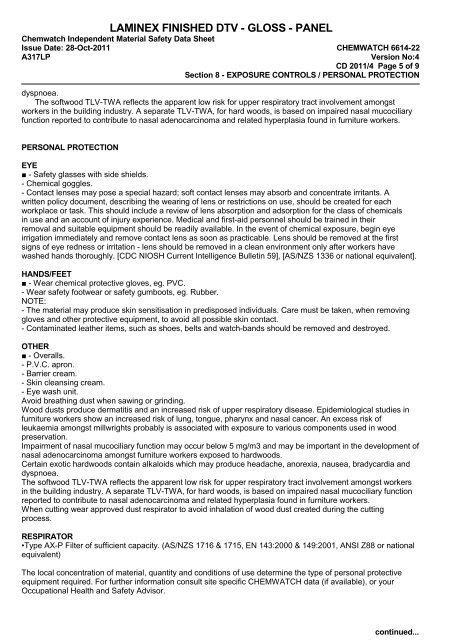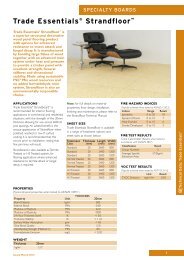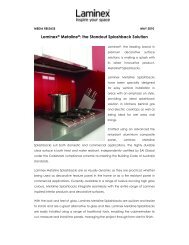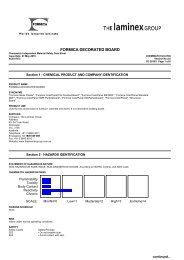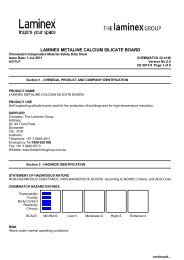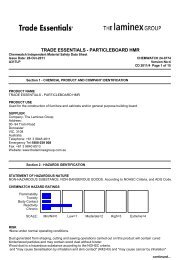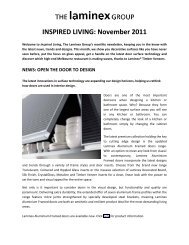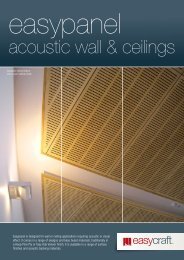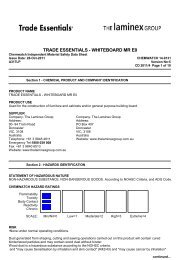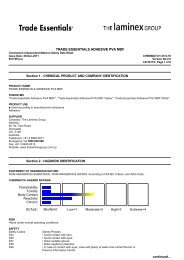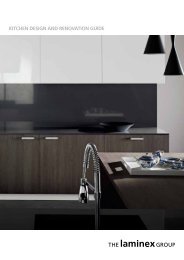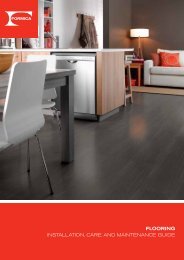Laminex Finished DTV - Gloss - Panel MSDS 6614-22
Laminex Finished DTV - Gloss - Panel MSDS 6614-22
Laminex Finished DTV - Gloss - Panel MSDS 6614-22
You also want an ePaper? Increase the reach of your titles
YUMPU automatically turns print PDFs into web optimized ePapers that Google loves.
LAMINEX FINISHED <strong>DTV</strong> - GLOSS - PANELChemwatch Independent Material Safety Data SheetIssue Date: 28-Oct-2011 CHEMWATCH <strong>6614</strong>-<strong>22</strong>A317LPVersion No:4CD 2011/4 Page 5 of 9Section 8 - EXPOSURE CONTROLS / PERSONAL PROTECTIONdyspnoea.The softwood TLV-TWA reflects the apparent low risk for upper respiratory tract involvement amongstworkers in the building industry. A separate TLV-TWA, for hard woods, is based on impaired nasal mucociliaryfunction reported to contribute to nasal adenocarcinoma and related hyperplasia found in furniture workers.PERSONAL PROTECTIONEYE■ - Safety glasses with side shields.- Chemical goggles.- Contact lenses may pose a special hazard; soft contact lenses may absorb and concentrate irritants. Awritten policy document, describing the wearing of lens or restrictions on use, should be created for eachworkplace or task. This should include a review of lens absorption and adsorption for the class of chemicalsin use and an account of injury experience. Medical and first-aid personnel should be trained in theirremoval and suitable equipment should be readily available. In the event of chemical exposure, begin eyeirrigation immediately and remove contact lens as soon as practicable. Lens should be removed at the firstsigns of eye redness or irritation - lens should be removed in a clean environment only after workers havewashed hands thoroughly. [CDC NIOSH Current Intelligence Bulletin 59], [AS/NZS 1336 or national equivalent].HANDS/FEET■ - Wear chemical protective gloves, eg. PVC.- Wear safety footwear or safety gumboots, eg. Rubber.NOTE:- The material may produce skin sensitisation in predisposed individuals. Care must be taken, when removinggloves and other protective equipment, to avoid all possible skin contact.- Contaminated leather items, such as shoes, belts and watch-bands should be removed and destroyed.OTHER■ - Overalls.- P.V.C. apron.- Barrier cream.- Skin cleansing cream.- Eye wash unit.Avoid breathing dust when sawing or grinding.Wood dusts produce dermatitis and an increased risk of upper respiratory disease. Epidemiological studies infurniture workers show an increased risk of lung, tongue, pharynx and nasal cancer. An excess risk ofleukaemia amongst millwrights probably is associated with exposure to various components used in woodpreservation.Impairment of nasal mucociliary function may occur below 5 mg/m3 and may be important in the development ofnasal adenocarcinoma amongst furniture workers exposed to hardwoods.Certain exotic hardwoods contain alkaloids which may produce headache, anorexia, nausea, bradycardia anddyspnoea.The softwood TLV-TWA reflects the apparent low risk for upper respiratory tract involvement amongst workersin the building industry. A separate TLV-TWA, for hard woods, is based on impaired nasal mucociliary functionreported to contribute to nasal adenocarcinoma and related hyperplasia found in furniture workers.When cutting wear approved dust respirator to avoid inhalation of wood dust created during the cuttingprocess.RESPIRATOR•Type AX-P Filter of sufficient capacity. (AS/NZS 1716 & 1715, EN 143:2000 & 149:2001, ANSI Z88 or nationalequivalent)The local concentration of material, quantity and conditions of use determine the type of personal protectiveequipment required. For further information consult site specific CHEMWATCH data (if available), or yourOccupational Health and Safety Advisor.continued...


